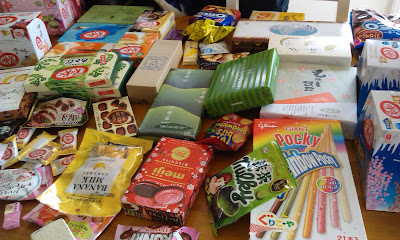On Things I Wish I'd Known About Japan
Two weeks ago today, I went on a long-anticipated ten-day trip to Japan, explaining partially the absence longer than necessary to post a new year's resolution. An amalgam of the old and traditional to the very updated and modern, Japan has always been a country I've longed to visit, boasting of unusual experiences, the sights, the shopping, and, of course, the food. On this trip I had four travel partners, all of whom have different interests, all of which contributed to our final itinerary (to be published later). A simple introduction of Travel Partners:
Dad
Authorial, headstrong, with a good eye for quality. Likes cameras, photography, shopping for clothes, and food.
Mom
Organised most, if not all, of the trip. Regardless, is quite mellow and easy-going. Likes shopping for clothes, Japanese Kit Kats, and food.
Sister #1
Goes with the flow. Likes shopping for clothes and cosmetics, Japanese snacks, and food in general.
Sister #2
Usually goes with the flow, with an inclination to push the group in a direction of personal interest. Likes art, manga, and food.
Despite thorough research and extensive digital Google Maps tours of the areas it was still inevitable that there were several boundaries we came came across that undoubtedly we wished we'd known prior to our travels. Though some may have been obvious, I think there's no way to stress enough some points that are quintessential for smoother travelling. After all, in Japan, with the thousands of things available, there's hardly time to spare for quarrelling and mishaps.
1. Plan Everything
This is, clearly, something that is natural to the process of travelling. Planning sites, times, researching directions, especially in a foreign country is inarguable. However, Japan was definitely a place where many aspects had to be carefully considered beforehand, as planning could influence events, as well as vice versa. One major example was the discovery that tickets to some museums, namely the Ghibli Studio and the Fujiko F. Fujio (Doraemon) museums both require pre-purchase of tickets at specific locations. While the Ghibli Studio Museum tickets were available for purchase through a travel agency, we had to locate Sis#1's friend, residing in Japan, to purchase the Doraemon Museum tickets in a convenience store. While it was possible to buy it after arrival, we thought it best to take no risks, as our plans were to visit them in the first two days, and there were no guarantees that we would secure spots, especially considering that there were allotted times.
Train Stations, Directions, and Exits
Unlike Singapore, I found Japan's train station system to be in an entirely different league of its own, especially in Tokyo. Some have several floors, multiple platforms, and several lines that run through one station, making it unbelievably easy to take the wrong train. This isn't something I don't think would be simple to research on Google, as Maps will tell you which line to take, but not necessarily the platform. Even worse, there is the occasion that some stations, such as the often-single line that runs through airports, will have trains that head in different directions, or trains of the same line of one platform being an express, meaning it may miss the intended station. However, it's also important to take note that there are many train attendants, often one on each platform, or two at each ticket gate, who will happily inform you of which platform to take for your intended destination. The language barrier is usually not a complication; many speak some English, and those who can't do their best using hand signals, or by pointing. If in doubt, ask.
Another important aspect to consider was the transport itself. Unbeknownst to us as we diligently walked ourselves through directions on the Google Maps tours, each train station has many exits, some stations labelling them with letters, numbers, or cardinal points. And, often emerging from a vast underground maze of areas, it is easy to confuse location. Though I had recalled reading "Exit 7" on Google Maps, it did not strike me as significant until the few occasions where we were thrown off by using a wrong exit and finding ourselves in an unfamiliar place despite heavy Google research. Though some stations label exits that lead to large landmarks or popular tourist destinations, take note of which exits to use. It will save a lot of time.
2. Japan Transport Passes
Japan Rail (JR) Passes
Under the large heading of "Planning" comes whether or not to purchase one of Japan's many transport passes. A major one is the Japan Rail (JR) Pass, which gives a user access to most train lines in Japan, some buses, and some ferries. However, as it is expensive, it is important that costs are calculated beforehand, and no rash purchases should be made for these passes: a seven-day JR Pass totalled to around NZ$350 per person, and unless you intend on taking more than two shinkansen (bullet train) rides, which can be about NZ$150-200 per person, then it is a waste of money to use it exclusively for $2 train rides within cities. Here is a fare chart of the cost between cities on the JR Shinkansens.
A reminder that the Japan Rail Pass can only be purchased outside of Japan, and the pass itself issued within the country with proof of foreign passport. Retaining the actual JR Pass, which can be done in major stations and at airports, can take some time as well, and we found that the offices are only open during the day, so ensure that this is incorporated in your schedule.
There is also the issue of JR Green Pass. These are more expensive, and allows a user to sit in more comfortable, reserved areas of shinkansen bullet trains, but beware if you mistake a Green carriage for an ordinary one; I've been told that people are charged extra if they are found seated the wrong carriage. Green carriages are not physically green, but are identified by the label of "Reserved Seats" on the electronic banner, or by the clover on the sides of such cars.
Also be aware that some lines are not available for use of the JR Pass, such as some buses, or private subway lines like the Tokyo Metro Line. In some cases, it may be required to purchase tickets to reach some stations. Searching public transport routes on Google Maps will give various options, and will indicate which lines are valid for JR Pass use.
Smaller Regional Passes
As well as the JR Pass there are also smaller regional passes, such as the Osaka Amazing Pass, available for purchase at major stations, can be used for a small number of days within their respective cities. Used well, they can save a lot of time money, though this, too, would require some consideration and calculation.
3. Small Convenient Things to Know
Handkerchiefs and Hygeine
Through reading manga, primarily shoujo manga, I'd always known that handkerchiefs in Japan are commonplace: a Japanese friend informed that generally everyone has one at hand, and while I had thought it was only a trend it has, in fact, a very important reason behind it: it is not unusual for public bathrooms not to supply a means of drying hands, and occasionally, soap. The lack of dryers or paper towels was bothersome, as the water was frigid, and we were visiting in January, during one of the coldest times of the year. Handkerchiefs are used (amongst other things), to dry one's hands after visiting the bathroom. Upon finding this out, Mom promptly bought a handkerchief, and used it happily throughout the trip, and Dad purchased a small face towel. A reminder to dry it every night, or it becomes unpleasant to use.
Rubbish Bins
It is difficult to find rubbish bins in public places, often resulting in one dragging for a couple of hours at a time, pockets full of snack wrappers or bags with empty plastic bottles and coffee cups. Bring a plastic bag, and dispose it at the sight of any bin. Also take note that some bins are used only for plastic bottles or cans (often indicated in the image of a can or bottle), so be careful of which you are discarding.
If You Want It, Buy It
Some products can only be found in certain places. Even for large chain stores, there have been times where items found in one branch are not available in another, such as a pair of shorts I wanted from Uniqlo. This may also be the case with food in convenience stores, and much more likely with novel snackfoods or drinks in vending machines.
While I realise that some of this information, especially regarding Japanese culture, may not be entirely correct, these are still things I wish I had known before travelling. I hope that this, in some way, helps somebody, and if there is something I've missed, or am mistaken about, please feel free to correct me.
Happy travels.
Dishes and Property
While it seems a strange notion, in some food courts and smaller hotels, dishes are returned to the kitchen by the diners themselves. This helps not only the staff, often busy with preparations, but also diners to identify which seats are available. As many people dine alone, leaving a dish or tray at a table guarantees them a place to return to. Personal property such as jackets or bags are also left in chairs to secure seats at empty tables, and while I would never consider doing this elsewhere, the honesty of the Japanese people means that the claim is respected, and the table left alone. Regardless, one can never be too careful.
While I realise that some of this information, especially regarding Japanese culture, may not be entirely correct, these are still things I wish I had known before travelling. I hope that this, in some way, helps somebody, and if there is something I've missed, or am mistaken about, please feel free to correct me.
Happy travels.



Comments
Post a Comment